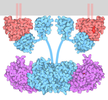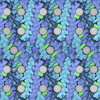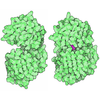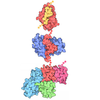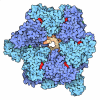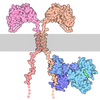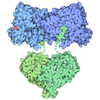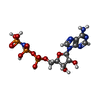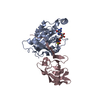+ データを開く
データを開く
- 基本情報
基本情報
| 登録情報 | データベース: PDB / ID: 8r3y | ||||||||||||
|---|---|---|---|---|---|---|---|---|---|---|---|---|---|
| タイトル | Cryo EM structure of a stable LGL/aPKC Iota/Par-6 complex | ||||||||||||
 要素 要素 |
| ||||||||||||
 キーワード キーワード | CYTOSOLIC PROTEIN / Kinase / Polarity / Kinase substrate complex. | ||||||||||||
| 機能・相同性 |  機能・相同性情報 機能・相同性情報Golgi cis cisterna / regulation of cellular localization / establishment of spindle orientation / Golgi vesicle budding / regulation of establishment or maintenance of cell polarity / PAR polarity complex / Tight junction interactions / diacylglycerol-dependent, calcium-independent serine/threonine kinase activity / cell-cell junction maintenance / protein kinase C ...Golgi cis cisterna / regulation of cellular localization / establishment of spindle orientation / Golgi vesicle budding / regulation of establishment or maintenance of cell polarity / PAR polarity complex / Tight junction interactions / diacylglycerol-dependent, calcium-independent serine/threonine kinase activity / cell-cell junction maintenance / protein kinase C / diacylglycerol-dependent serine/threonine kinase activity / establishment of apical/basal cell polarity / myosin II binding / negative regulation of glial cell apoptotic process / regulation of Notch signaling pathway / eye photoreceptor cell development / positive regulation of protein localization to centrosome / Schmidt-Lanterman incisure / Golgi to plasma membrane transport / establishment or maintenance of epithelial cell apical/basal polarity / GTP-dependent protein binding / cellular response to chemical stress / membrane organization / cell-cell junction organization / centrosome cycle / tight junction / cortical actin cytoskeleton organization / protein targeting to membrane / RHOV GTPase cycle / cortical actin cytoskeleton / positive regulation of Notch signaling pathway / establishment or maintenance of cell polarity / establishment of cell polarity / exocytosis / cell leading edge / brush border / RHOU GTPase cycle / CDC42 GTPase cycle / positive regulation of endothelial cell apoptotic process / bicellular tight junction / viral process / regulation of postsynaptic membrane neurotransmitter receptor levels / intercellular bridge / vesicle-mediated transport / positive regulation of glial cell proliferation / ruffle / cytoskeleton organization / RAC1 GTPase cycle / p75NTR recruits signalling complexes / response to interleukin-1 / secretion / axonogenesis / GTPase activator activity / actin filament organization / trans-Golgi network membrane / TGF-beta receptor signaling in EMT (epithelial to mesenchymal transition) / protein localization to plasma membrane / positive regulation of protein secretion / positive regulation of D-glucose import / Asymmetric localization of PCP proteins / positive regulation of protein localization to plasma membrane / adherens junction / positive regulation of NF-kappaB transcription factor activity / positive regulation of neuron projection development / phospholipid binding / Schaffer collateral - CA1 synapse / Pre-NOTCH Transcription and Translation / small GTPase binding / centriolar satellite / cellular response to insulin stimulus / KEAP1-NFE2L2 pathway / cell migration / microtubule cytoskeleton / protein-containing complex assembly / cell cortex / early endosome membrane / negative regulation of neuron apoptotic process / cytoskeleton / endosome / protein kinase activity / intracellular signal transduction / cilium / protein phosphorylation / apical plasma membrane / axon / Golgi membrane / cell division / protein serine kinase activity / protein serine/threonine kinase activity / intracellular membrane-bounded organelle / centrosome / negative regulation of apoptotic process / protein kinase binding / glutamatergic synapse / structural molecule activity / extracellular exosome / zinc ion binding / nucleoplasm / ATP binding / nucleus 類似検索 - 分子機能 | ||||||||||||
| 生物種 |  Homo sapiens (ヒト) Homo sapiens (ヒト) | ||||||||||||
| 手法 | 電子顕微鏡法 / 単粒子再構成法 / クライオ電子顕微鏡法 / 解像度: 3.68 Å | ||||||||||||
 データ登録者 データ登録者 | Earl, C.P. / Briggs, D.C. / McDonald, N.Q. | ||||||||||||
| 資金援助 |  英国, 3件 英国, 3件
| ||||||||||||
 引用 引用 |  ジャーナル: Nat Struct Mol Biol / 年: 2025 ジャーナル: Nat Struct Mol Biol / 年: 2025タイトル: Capture, mutual inhibition and release mechanism for aPKC-Par6 and its multisite polarity substrate Lgl. 著者: Christopher P Earl / Mathias Cobbaut / André Barros-Carvalho / Marina E Ivanova / David C Briggs / Eurico Morais-de-Sá / Peter J Parker / Neil Q McDonald /   要旨: The mutually antagonistic relationship of atypical protein kinase C (aPKC) and partitioning-defective protein 6 (Par6) with the substrate lethal (2) giant larvae (Lgl) is essential for regulating ...The mutually antagonistic relationship of atypical protein kinase C (aPKC) and partitioning-defective protein 6 (Par6) with the substrate lethal (2) giant larvae (Lgl) is essential for regulating polarity across many cell types. Although aPKC-Par6 phosphorylates Lgl at three serine sites to exclude it from the apical domain, aPKC-Par6 and Lgl paradoxically form a stable kinase-substrate complex, with conflicting roles proposed for Par6. We report the structure of human aPKCι-Par6α bound to full-length Llgl1, captured through an aPKCι docking site and a Par6 contact. This complex traps a phospho-S663 Llgl1 intermediate bridging between aPKC and Par6, impeding phosphorylation progression. Thus, aPKCι is effectively inhibited by Llgl1 while Llgl1 is captured by aPKCι-Par6. Mutational disruption of the Lgl-aPKC interaction impedes complex assembly and Lgl phosphorylation, whereas disrupting the Lgl-Par6 contact promotes complex dissociation and Lgl phosphorylation. We demonstrate a Par6-regulated substrate capture-and-release model requiring binding by active Cdc42 and the apical partner Crumbs to drive complex disassembly. Our results suggest a mechanism for mutual regulation and spatial control of aPKC-Par6 and Lgl activities. | ||||||||||||
| 履歴 |
|
- 構造の表示
構造の表示
| 構造ビューア | 分子:  Molmil Molmil Jmol/JSmol Jmol/JSmol |
|---|
- ダウンロードとリンク
ダウンロードとリンク
- ダウンロード
ダウンロード
| PDBx/mmCIF形式 |  8r3y.cif.gz 8r3y.cif.gz | 453.5 KB | 表示 |  PDBx/mmCIF形式 PDBx/mmCIF形式 |
|---|---|---|---|---|
| PDB形式 |  pdb8r3y.ent.gz pdb8r3y.ent.gz | 364.7 KB | 表示 |  PDB形式 PDB形式 |
| PDBx/mmJSON形式 |  8r3y.json.gz 8r3y.json.gz | ツリー表示 |  PDBx/mmJSON形式 PDBx/mmJSON形式 | |
| その他 |  その他のダウンロード その他のダウンロード |
-検証レポート
| 文書・要旨 |  8r3y_validation.pdf.gz 8r3y_validation.pdf.gz | 1.5 MB | 表示 |  wwPDB検証レポート wwPDB検証レポート |
|---|---|---|---|---|
| 文書・詳細版 |  8r3y_full_validation.pdf.gz 8r3y_full_validation.pdf.gz | 1.5 MB | 表示 | |
| XML形式データ |  8r3y_validation.xml.gz 8r3y_validation.xml.gz | 48.6 KB | 表示 | |
| CIF形式データ |  8r3y_validation.cif.gz 8r3y_validation.cif.gz | 73.8 KB | 表示 | |
| アーカイブディレクトリ |  https://data.pdbj.org/pub/pdb/validation_reports/r3/8r3y https://data.pdbj.org/pub/pdb/validation_reports/r3/8r3y ftp://data.pdbj.org/pub/pdb/validation_reports/r3/8r3y ftp://data.pdbj.org/pub/pdb/validation_reports/r3/8r3y | HTTPS FTP |
-関連構造データ
| 関連構造データ |  18877MC  8r3xC M: このデータのモデリングに利用したマップデータ C: 同じ文献を引用 ( |
|---|---|
| 類似構造データ | 類似検索 - 機能・相同性  F&H 検索 F&H 検索 |
- リンク
リンク
- 集合体
集合体
| 登録構造単位 | 
|
|---|---|
| 1 |
|
- 要素
要素
| #1: タンパク質 | 分子量: 39146.004 Da / 分子数: 1 / 由来タイプ: 組換発現 / 由来: (組換発現)  Homo sapiens (ヒト) / 遺伝子: PRKCI, DXS1179E / 細胞株 (発現宿主): HEK293 FreeStyle / 発現宿主: Homo sapiens (ヒト) / 遺伝子: PRKCI, DXS1179E / 細胞株 (発現宿主): HEK293 FreeStyle / 発現宿主:  Homo sapiens (ヒト) / 参照: UniProt: P41743, protein kinase C Homo sapiens (ヒト) / 参照: UniProt: P41743, protein kinase C |
|---|---|
| #2: タンパク質 | 分子量: 101889.805 Da / 分子数: 1 / 由来タイプ: 組換発現 / 由来: (組換発現)  Homo sapiens (ヒト) / 遺伝子: LLGL1, DLG4, HUGL, HUGL1 / 細胞株 (発現宿主): HEK293 Freestyle / 発現宿主: Homo sapiens (ヒト) / 遺伝子: LLGL1, DLG4, HUGL, HUGL1 / 細胞株 (発現宿主): HEK293 Freestyle / 発現宿主:  Homo sapiens (ヒト) / 参照: UniProt: Q15334 Homo sapiens (ヒト) / 参照: UniProt: Q15334 |
| #3: タンパク質 | 分子量: 10856.517 Da / 分子数: 1 / 由来タイプ: 組換発現 / 由来: (組換発現)  Homo sapiens (ヒト) / 遺伝子: PARD6A, PAR6A / 細胞株 (発現宿主): HEK293 Freestyle / 発現宿主: Homo sapiens (ヒト) / 遺伝子: PARD6A, PAR6A / 細胞株 (発現宿主): HEK293 Freestyle / 発現宿主:  Homo sapiens (ヒト) / 参照: UniProt: Q9NPB6 Homo sapiens (ヒト) / 参照: UniProt: Q9NPB6 |
| #4: 化合物 | ChemComp-ANP / |
| 研究の焦点であるリガンドがあるか | N |
| Has protein modification | Y |
-実験情報
-実験
| 実験 | 手法: 電子顕微鏡法 |
|---|---|
| EM実験 | 試料の集合状態: PARTICLE / 3次元再構成法: 単粒子再構成法 |
- 試料調製
試料調製
| 構成要素 | 名称: aPKCiota-Par6-Llgl1 complex / タイプ: COMPLEX / Entity ID: #1-#3 / 由来: RECOMBINANT | ||||||||||||||||
|---|---|---|---|---|---|---|---|---|---|---|---|---|---|---|---|---|---|
| 分子量 | 値: 0.22 MDa / 実験値: NO | ||||||||||||||||
| 由来(天然) | 生物種:  Homo sapiens (ヒト) Homo sapiens (ヒト) | ||||||||||||||||
| 由来(組換発現) | 生物種:  Homo sapiens (ヒト) / 細胞: HEK293 Freestyle Homo sapiens (ヒト) / 細胞: HEK293 Freestyle | ||||||||||||||||
| 緩衝液 | pH: 7.5 | ||||||||||||||||
| 緩衝液成分 |
| ||||||||||||||||
| 試料 | 濃度: 0.4 mg/ml / 包埋: NO / シャドウイング: NO / 染色: NO / 凍結: YES 詳細: Sample was double affinity purified and gel filtered. Sample was monodisperse. | ||||||||||||||||
| 試料支持 | 詳細: 45mA / グリッドの材料: COPPER / グリッドのタイプ: Quantifoil R1.2/1.3 | ||||||||||||||||
| 急速凍結 | 装置: FEI VITROBOT MARK IV / 凍結剤: ETHANE / 湿度: 100 % / 凍結前の試料温度: 298 K 詳細: 4 ul of aPKCiota-Par6-Llgl1 complex at a concentration of 0.4 mg/ml was applied to R1.2/1.3 Quantifoil 300 mesh copper grids which had been glow-discharged for 45 s at 45 mA . Grids were ...詳細: 4 ul of aPKCiota-Par6-Llgl1 complex at a concentration of 0.4 mg/ml was applied to R1.2/1.3 Quantifoil 300 mesh copper grids which had been glow-discharged for 45 s at 45 mA . Grids were blotted for 2.5 s at 100% humidity using an FEI Vitrobot MK IV. |
- 電子顕微鏡撮影
電子顕微鏡撮影
| 実験機器 |  モデル: Titan Krios / 画像提供: FEI Company |
|---|---|
| 顕微鏡 | モデル: FEI TITAN KRIOS |
| 電子銃 | 電子線源:  FIELD EMISSION GUN / 加速電圧: 300 kV / 照射モード: FLOOD BEAM FIELD EMISSION GUN / 加速電圧: 300 kV / 照射モード: FLOOD BEAM |
| 電子レンズ | モード: BRIGHT FIELD / 最大 デフォーカス(公称値): 3000 nm / 最小 デフォーカス(公称値): 1200 nm |
| 試料ホルダ | 凍結剤: NITROGEN 試料ホルダーモデル: FEI TITAN KRIOS AUTOGRID HOLDER |
| 撮影 | 平均露光時間: 8 sec. / 電子線照射量: 48.1 e/Å2 / 検出モード: COUNTING フィルム・検出器のモデル: GATAN K2 SUMMIT (4k x 4k) 実像数: 4002 |
| 電子光学装置 | エネルギーフィルター名称: GIF Quantum ER |
| 画像スキャン | 動画フレーム数/画像: 40 |
- 解析
解析
| EMソフトウェア |
| ||||||||||||||||||||||||||||||||||||||||
|---|---|---|---|---|---|---|---|---|---|---|---|---|---|---|---|---|---|---|---|---|---|---|---|---|---|---|---|---|---|---|---|---|---|---|---|---|---|---|---|---|---|
| CTF補正 | タイプ: PHASE FLIPPING ONLY | ||||||||||||||||||||||||||||||||||||||||
| 粒子像の選択 | 選択した粒子像数: 1069057 詳細: Semi-automated picking with Xmipp3 and particle extraction in Relion-3 yielded 47,516 particles from 1000 micrographs 38. After reference-free 2D classification in Relion-3, eight 2D classes ...詳細: Semi-automated picking with Xmipp3 and particle extraction in Relion-3 yielded 47,516 particles from 1000 micrographs 38. After reference-free 2D classification in Relion-3, eight 2D classes were selected and used as templates for reference-based particle picking in Gautomatch. A total of particles were extracted with 2-fold binning and submitted to 8 rounds of 2D classification in Relion-3. | ||||||||||||||||||||||||||||||||||||||||
| 対称性 | 点対称性: C1 (非対称) | ||||||||||||||||||||||||||||||||||||||||
| 3次元再構成 | 解像度: 3.68 Å / 解像度の算出法: FSC 0.143 CUT-OFF / 粒子像の数: 121194 / クラス平均像の数: 1 / 対称性のタイプ: POINT | ||||||||||||||||||||||||||||||||||||||||
| 原子モデル構築 | プロトコル: FLEXIBLE FIT / 空間: REAL 詳細: Initial fitting was done in Chimera. Interactive Model building was done in COOT & Isolde Refinement was done using Phenix. | ||||||||||||||||||||||||||||||||||||||||
| 原子モデル構築 | 3D fitting-ID: 1 / Source name: PDB / タイプ: experimental model
| ||||||||||||||||||||||||||||||||||||||||
| 拘束条件 |
|
 ムービー
ムービー コントローラー
コントローラー



 PDBj
PDBj